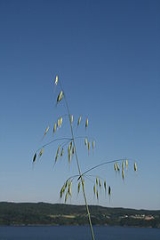
Avena fatua
Encyclopedia
Avena fatua is a species of grass
in the oat genus
. It is known as the common wild oat. This oat is native to Eurasia but it has been introduced
to most of the other temperate regions of the world. It is naturalized in some areas and considered a noxious weed in others. It is a typical oat in appearance, a green grass with hollow, erect stems 1 to 4 feet tall bearing nodding panicle
s of spikelets
. The long dark green leaves are up to a centimeter wide and rough due to small hairs. The seedlings are also hairy. This and other wild oat
s can become troublesome in prairie agriculture when it invades and lowers the quality of a field crop, or competes for resources with the crop plants. It takes very few wild oat plants to cause a significant reduction in the yield of a wheat
or cultivated oat
field, even though the seeds are a type of oat.
Poaceae
The Poaceae is a large and nearly ubiquitous family of flowering plants. Members of this family are commonly called grasses, although the term "grass" is also applied to plants that are not in the Poaceae lineage, including the rushes and sedges...
in the oat genus
Avena
The oats are a genus of 10-15 species of true grasses . They are native to Europe, Asia and northwest Africa. One species is widely cultivated elsewhere, and several have become naturalized in many parts of the world...
. It is known as the common wild oat. This oat is native to Eurasia but it has been introduced
Introduced species
An introduced species — or neozoon, alien, exotic, non-indigenous, or non-native species, or simply an introduction, is a species living outside its indigenous or native distributional range, and has arrived in an ecosystem or plant community by human activity, either deliberate or accidental...
to most of the other temperate regions of the world. It is naturalized in some areas and considered a noxious weed in others. It is a typical oat in appearance, a green grass with hollow, erect stems 1 to 4 feet tall bearing nodding panicle
Panicle
A panicle is a compound raceme, a loose, much-branched indeterminate inflorescence with pedicellate flowers attached along the secondary branches; in other words, a branched cluster of flowers in which the branches are racemes....
s of spikelets
Raceme
A raceme is a type of inflorescence that is unbranched and indeterminate and bears pedicellate flowers — flowers having short floral stalks called pedicels — along the axis. In botany, axis means a shoot, in this case one bearing the flowers. In a raceme, the oldest flowers are borne...
. The long dark green leaves are up to a centimeter wide and rough due to small hairs. The seedlings are also hairy. This and other wild oat
Wild oat
Wild oat may refer to:*Common wild oat or Avena fatua*Slender wild oat or Avena barbata*Winter wild oat or Avena sterilis...
s can become troublesome in prairie agriculture when it invades and lowers the quality of a field crop, or competes for resources with the crop plants. It takes very few wild oat plants to cause a significant reduction in the yield of a wheat
Wheat
Wheat is a cereal grain, originally from the Levant region of the Near East, but now cultivated worldwide. In 2007 world production of wheat was 607 million tons, making it the third most-produced cereal after maize and rice...
or cultivated oat
Oat
The common oat is a species of cereal grain grown for its seed, which is known by the same name . While oats are suitable for human consumption as oatmeal and rolled oats, one of the most common uses is as livestock feed...
field, even though the seeds are a type of oat.

